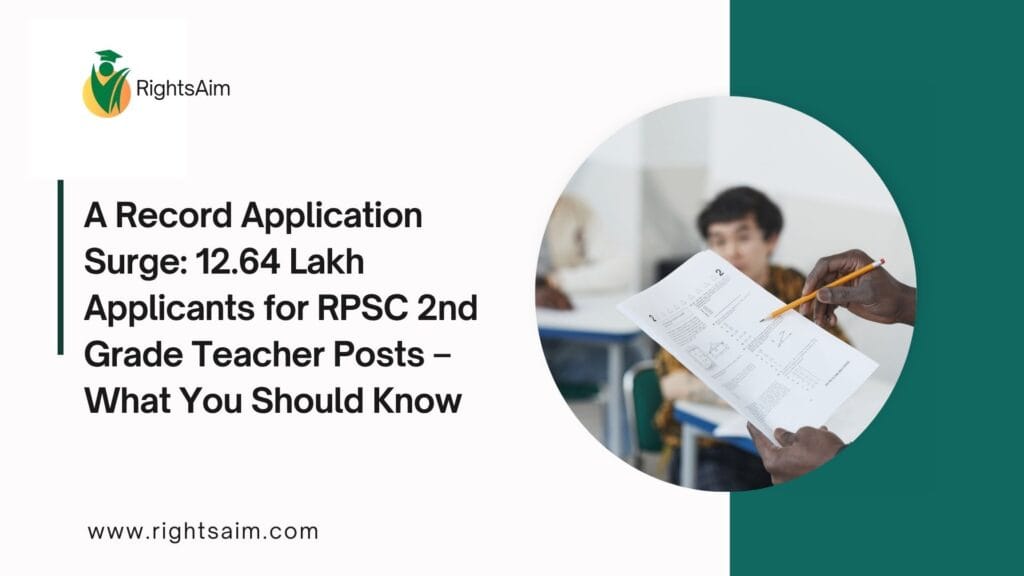The education-sector recruitment landscape in Rajasthan has been shaken by a staggering figure — approximately 12.64 lakh (1.264 million) applications pouring in for the recent 2nd Grade Teacher (Senior Teacher Gr. II) recruitment drive of the Rajasthan Public Service Commission (RPSC). This unprecedented interest underscores not only the aspiration among teaching-profession hopefuls but also the fierce competition that lies ahead across subjects and regions.

Table of Contents
Why such a large number of applicants?
Several factors contribute to this surge in applications:
Limited vacancy vs high demand: While RPSC has announced large numbers of posts, the number of eligible candidates far outstrips the available seats. For example, in the 2025 notification, the RPSC announced about 6,500 vacancies across subjects (5,804 in Non-TSP areas and 696 in TSP areas) for Senior Teachers in subjects including Hindi, English, Maths, Science, Sanskrit, Social Science, Urdu, Punjabi, Sindhi and Gujarati. When more than ten times that number of applications arrive, competition becomes apparent.
Career security & prestige: A government teaching post in Rajasthan is often viewed as stable, with social respect, opportunities for professional growth and decent remuneration. Many applicants see it as a preferred career path.
Subject-wise appeal & location factors: Some subjects and regions attract even more applicants because of better chances (or perceived chances), or because candidates from particular backgrounds specialise in them. With subject-wise vacancy breakdowns (e.g., Maths: 1,385 posts; English: 1,305 posts; Science: 1,355 posts) 1the competition in each subject is logically different.
Increased awareness & easier access: With more awareness of such recruitment drives and easier online application portals, more candidates are participating than before.
What does “subject-wise application” mean?
When we refer to subject-wise applications, we mean the number of applications received (or expected) in each subject (Hindi, English, Maths, etc.). While exact official breakdowns by subject may not yet be publicly released for this specific wave, the vacancy table gives us insight into where the demand could be highest.
For example:
Maths has 1,385 posts (1,184 Non-TSP + 201 TSP)
Science has 1,355 posts (1,160 Non-TSP + 195 TSP)
English has 1,305 posts (1,150 Non-TSP + 155 TSP)
Hindi has 1,052 posts (1,005 Non-TSP + 47 TSP)
Given the same total application pool of 12.64 lakh, we can infer that high-vacancy subjects (Maths, Science, English) might have drawn proportionately more applicants — meaning competition in those might be fiercest.
Implications for aspirants
Competition ratio skyrockets: If 12.64 lakh applications are considered against 6,500 posts, the “applications per post” average is roughly 195 applicants per post. But because subject-wise vacancies differ, actual competition may vary — often higher in popular subjects and accessible locations.
Need for smart preparation: High competition means that simply passing may not be enough; candidates will need high scores, strong preparation in subject-specific knowledge, exam strategy, and clarity on the syllabus/pattern. For the 2025 exam, the syllabus is divided into two papers (Paper I: 200 marks; Paper II: 300 marks) with negative marking.
Subject-choice strategy matters: Applicants must be realistic about their strengths, subject preferences and competition levels. If a candidate is equally good in two subjects, opting for the less-popular subject (fewer applicants) might increase chances.
Regional issues (TSP vs Non-TSP): TSP (Tribal Sub-Plan) areas have fewer posts (e.g., 696 total TSP vacancies for 2025) compared with Non-TSP areas (5,804) Applicants should weigh regional postings, reservations, and preparation accordingly.
Cut-off scores will climb: With more applicants, the cutoff marks for each subject/category will likely be higher. Past years reflect this trend.
Document verification & eligibility filters will weed many out: With so many applications, strict eligibility checks (education qualification, age, category, document proof) will become a key filter before the written exam.
Preparation tips for candidates
Understand the syllabus & pattern thoroughly: Make sure you know Paper I and Paper II structure, topics for your subject, and the negative marking system.
Subject-specific deep dive: Since competition is intense, subject strength (for example, for Maths, Science or English) is critical. Use previous year papers and mock tests.
Time-management & accuracy: With huge applicant pools, high scores will be vital. Practice to increase accuracy and speed.
Stay updated with official notifications: Keep checking the RPSC website for subject-wise application updates, exam date declarations and admit cards.
Choose subject/region wisely: Consider your comfort with the subject plus realistic competition. If applying for TSP vs Non-TSP, check vacancy distribution in your subject.
Mind backing up documents and eligibility: Ensure your educational/teacher-education credentials are in order (for example, B.Ed/DElEd where required) to avoid rejection at verification.
FAQs
Q: Is the figure of 12.64 lakh applications official?
A: This figure has been reported widely and is representative of the massive application count for the recruitment wave. Even if subject-wise breakdowns are awaited, the scale of applications is clear.Q: How many vacancies are being offered overall?
A: For the 2025 cycle, RPSC has announced 6,500 Senior Teacher (2nd Grade) vacancies across various subjects.Q: Which subjects have the most vacancies?
A: Subject-wise for 2025:Maths: 1,385 posts
Science: 1,355 posts
English: 1,305 posts
Hindi: 1,052 posts
Q: What does TSP vs Non-TSP mean?
A: TSP stands for Tribal Sub-Plan areas, earmarked for tribal populations in Rajasthan. Posts are distributed between TSP and Non-TSP regions; for instance, for 2025: 696 posts in TSP and 5,804 posts in Non-TSP.Q: What is the exam pattern?
A: For the 2025 cycle, the written examination consists of two papers: Paper I (200 marks) and Paper II (300 marks) for a total of 500 marks. Negative marking applies (¼ or ⅓ penalty) for wrong answers.Q: With so many applicants, what are my chances?
A: While competition is very stiff (over 100-200 applicants per post in many subjects), a well-planned, subject-focused preparation can still give you a competitive edge. Choosing subjects wisely, leveraging strengths, and practising intensively are key.Q: When will the subject-wise application data be released by RPSC?
A: The official subject-wise application statistics are usually published by RPSC in the recruitment bulletin or press note, though not always immediately. Candidates should monitor the RPSC website for updates. rpsc.rajasthan.gov.in+1Q: Is there any strategy for subjects with fewer vacancies (like Punjabi, Gujarati, Sindhi)?
A: Yes — although vacancies may be fewer (e.g., Punjabi: 11 posts; Sindhi: 2 posts) fewer posts often mean higher competition per post, but they may also attract fewer applicants if fewer candidates specialise in those subjects. If you are confident in such a subject, you might benefit from niche competition.Q: Are there age or qualification criteria differences for each subject?
A: Yes, each subject may have its own eligibility requirements. For example, for certain subjects, a candidate must hold a relevant Bachelor’s degree with the subject as an optional, plus B.Ed/DElEd. Always check the official notification for subject-wise criteria.Q: When is the exam likely to be held?
A: According to the 2025 cycle, the exam is scheduled between 12th & 18th July 2026 (for Senior Teacher Competitive Exam) according to one source. But dates may change and must be checked on the official portal.Q: Will more vacancies be announced in future?
A: It is possible. RPSC periodically announces recruitment for Senior Teachers, and future cycles may have different vacancy numbers. Stay updated with official notification releases.Q: What difference will subject-wise competition make in scoring/cut-offs?
A: Subjects with higher applications and fewer posts may have higher cut-offs. Past data shows that subjects and areas with heavy applicant numbers have higher minimum qualifying scores.
Conclusion
The flood of 12.64 lakh applications for RPSC’s 2nd Grade Teacher recruitment is a clear sign of how much significance such government teaching posts hold across Rajasthan. While the opportunity is attractive, the competition is intense. For candidates, subject awareness, strategic preparation and disciplined work will make the difference. Knowing your subject inside-out, choosing your region smartly, and staying on top of official announcements can significantly increase your chances of success.
If


